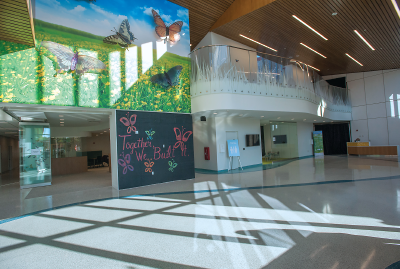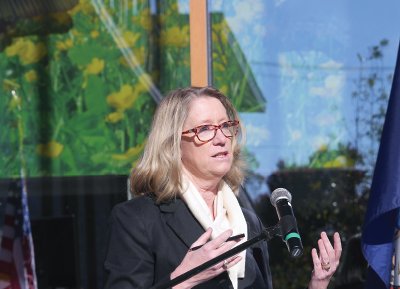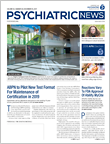Indoor gardens, green spaces, an abundance of natural light, overnight accommodations for family members, and a homelike environment: these may not be the characteristics that come immediately to mind when you think of a typical hospital. But they, along with other features, make the new Virginia Treatment Center for Children (VTCC) stand out for its innovative “therapeutic environment.”
The center, scheduled to open early in 2018, incorporates state-of-the-art features in health care facility design, with a special focus on the needs of children and adolescents with mental illness and/or substance use disorders.
It replaces the existing facility in downtown Richmond, now more than 50 years old. Originally established as a state facility, it was threatened with closure by the governor in the early 1990s. Community activists succeeded in keeping the facility open, and operation of VTCC was transferred to the pediatric division of the Virginia Commonwealth University (VCU) Medical Center’s Department of Psychiatry and the Children’s Hospital of Richmond at VCU.
The new building spans 4.5 acres and includes 32 private inpatient rooms. Each bedroom has a window seat and accommodations for parents to spend the night. There are 20 outpatient consult rooms, indoor gardens, the Children’s Mental Health Resource Center, and the Commonwealth Institute for Child and Family Studies, which will serve as the research arm of VTCC. There is a K-12 classroom area where teachers from the Richmond school district will help patients keep up with schoolwork.
VTCC is the culmination of years of advocacy by community leaders and bipartisan support in the Virginia General Assembly, resulting in $56 million in state funding to supplement funds from private donors.
APA President Anita Everett, M.D., was joined at a ribbon-cutting ceremony last month by nine other leaders in public health and psychiatry who hailed the bipartisan effort and community activism that helped make the new treatment center a reality. Noting that many of the children and adolescents who will be treated at VTCC have a history of trauma, Everett said the center represents a recognition of the importance of family, community, and environmental factors in health and illness.
Everett said that focus marks the “third wave” in the history of public health, following the earlier emphases on infectious disease and chronic illness. “The new Virginia Treatment Center for Children is visionary in its dedication to addressing the social determinants of health and sets a standard for the rest of the nation to follow,” Everett said.
Other speakers at the event included William Hazel Jr., M.D., secretary of health and human resources for the Commonwealth of Virginia; Michael Rao, Ph.D., president of VCU and the VCU Health System; psychiatrist Peter F. Buckley, M.D., dean of the VCU School of Medicine; and Joel Silverman, M.D., professor and chair of the VCU Department of Psychiatry.
Everett and others at the ceremony emphasized the unique design of the new VTCC, which reflects a trend away from the institutional nature of many behavioral health care facilities. In the 2013 report “Design Research and Behavioral Health Facilities,” Mardelle Shepley of Cornell University and colleagues with the Behavioral Health Facilities Working Group of the Center for Health Design wrote that over the last 20 years “there has been a transition from creating visually plain environments (so as not to overstimulate patients) to richer, more complex spaces and increased access to the outdoors.”
They added, “The primary trends in contemporary psychiatric facility design address environments that support recovery, induce shorter stays, and allow patients to participate in their treatment. Environments that support recovery likely involve access to natural light and the outdoors and artwork involving nature. … Other trends include the increased need to provide environments that address program spaces for drug and alcohol addiction and the more common use of single-patient rooms.”
If VTCC represents a trend in ideal design, what may be distinctive about the center is the public commitment that made it a reality. In interviews with Psychiatric News, Silverman and Alexandria Lewis, Ed.D., director of the center and an assistant professor of psychiatry at VCU, emphasized the financial support provided by the Virginia General Assembly and the work of community activists over many years.
Lewis said VTCC began in the 1960s as a state-operated facility and was transferred to VCU in the early 1990s. A coalition of community groups including the local NAMI chapter and Voices for Virginia’s Children, among others, advocated for a feasibility analysis to replace the existing VTCC. When that report was sent to the General Assembly, the response was a commitment of $56 million toward construction of a new center. Approximately 60 percent of the children and adolescents served by VTCC come from the Richmond area, but the rest are from all over the Commonwealth, she said.
Silverman said he believes the rebuilt facility reflects a realization by the community and the General Assembly that providing psychiatric care to children is a wise investment in the future. “This combined with our strong Department of Psychiatry at VCU helped to move this project forward,” he told Psychiatric News. “We traveled around the country looking at other facilities and consulted with experts in the U.S. and Europe about what was the state of the art. We wanted to be better than the state of the art.”
Of the new VTCC, Silverman said, “It doesn’t look like a hospital. It’s inspirational, not institutional.” ■


